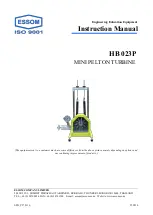
ESSOM COMPANY LIMITED
Section 2: Theory
2
SECTION 2: THEORY
General Theory
A water turbine is a hydraulic machine for transforming fluid energy into useful mechanical work at a rotating shaft
.
The power engineer is concerned with the generation of this shaft work in a hydro power plant from the stored mechanical
potential energy in a body of water behind a dam
.
Electrical engineer is interested in the conversion of the shaft work into
electric energy in a generator and the transmission of the electrical energy over the transmission lines to various
convenient locations where it can be transformed into work, heat, light or sound
.
In general consideration for hydraulic machinery, especially hydro turbines and pumps, it is customary to express the
various forms of energy in terms of “head” representing the column of water equivalent to the energy at a particular point
in the flow system
.
The static head or potential energy of water column of the hydro turbine power plant is totally relied
upon the height of the dam to create maximum output potential at the construction site
.
This total head of a power plant
is the vertical distance from the tail water elevation to the water level of the dam reservoir
.
Various forms of energy of
water expressed in terms of head of water
(
in unit length
)
representing energy per unit weight of water are as follows
:
2
.
1 Pressure and Head
▪
Atmospheric pressure
Atmospheric pressure is the ratio between the weights of the atmosphere per unit area on the earth surface
.
Thus
one atmospheric pressure is equal to 101
.
325 kilo
-
Newton per square meter
(
2
kN / m
)
or 14
.
7 pound per square inch
(
psi
).
Since barometer is used to measure atmospheric pressure, this pressure is often referred to as Barometric pressure,
atm
p
.
Pressure on a pressure gauge is pressure above atmospheric pressure
.
▪
Pressure Head
(
/
p
)
The value of pressure is normally expressed as a unit force per unit area such as Newton per square meter
(
N
/
m
2
)
,
Pound per square inch
(
psi
)
, or Kilogram per square centimeter
(
kg
/
cm
2
).
In case of hydraulic pressure it is customary
expressed as a height of a fluid column which exerts the same pressure on an area supporting the column
.
This height is
called pressure head
.
▪
Velocity Head
(
/
2
2
v
H V
g
)
When liquid flows in a pipe or in an open channel it has kinetic energy
.
Kinetic energy per unit weight of liquid is
called velocity head
.
▪
Elevation Head or Static Head
(
Z
)
When a liquid is at an elevation it has potential energy
.
Potential energy per unit weight of liquid is called Elevation
head
or static head
.
Potential energy of the object at the elevation Z
.
▪
Total head
(
H
)
Total head of liquid at any point is the total energy per unit weight of liquid and equal to the summation of pressure
head, velocity head and elevation head of liquid
.
Thus, the total head is
:
2
Total head =
2
p
V
Z
g
(
2.1
)
Where
:
p
=
pressure head, m
p
=
pressure,
2
N / m
=
specific weight,
3
N / m
V
=
velocity, m
/
s
g
=
acceleration due to gravity,
2
m / s
Z
=
elevation, m






















